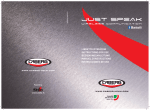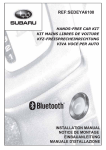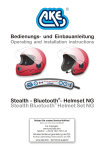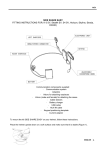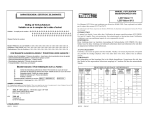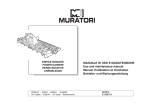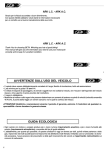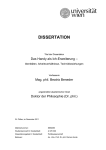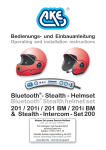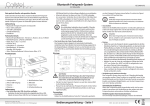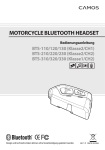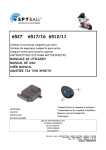Download www .hello-biker.com
Transcript
INTERFONO senza fili con funzione VIVAVOCE (*) Wireless INTERCOM SYSTEM with HANDS-FREE function (*) Système INTERCOM sans fil avec fonction MAINS LIBRES (*) Kabellose GEGENSPRECHANLAGE mit FREISPRECHSYSTEM (*) www.hello-biker.com (*) disponibile se il sistema è abbinato ad un cellulare con tecnologia wireless BLUETOOTH ® (*) available if the system is paired with a BLUETOOTH ® technology cellular phone (*) disponible si le système est couplé à un téléphone portable avec technologie BLUETOOTH ® (*) nur verfügbar, wenn das System mit einem BLUETOOTH ® Handy angeschlossen wird Illustrazioni, descrizioni e caratteristiche sono fornite solo a titolo indicativo. Il fabbricante si riserva il diritto di modificarle senza preavviso. COBRA AT declina qualsiasi responsabilità per danni a persone o cose derivanti da installazione non conforme alle prescrizioni qui contenute oppure da utilizzo inadeguato. Diagrams, descriptions and features are merely indicative. The manufacturer reserves the right to modify them without notice. COBRA AT will not be responsible for damage to people or things resulting from negligence of these instructions or improper use. Les illustrations, les descriptions et les caractéristiques sont fournies uniquement à titre indicatif. Le fabricant se réserve le droit de les modifier sans préavis. COBRA AT rejette toute responsabilité en cas de pannes/dommages imputables à l’installation ou à l’utilisation non conformes aux spécifications fournies. Abbildungen, Beschreibungen und Eigenschaften werden nur unverbindlich angegeben. Der Hersteller behält es sich vor, ohne Vorbescheid Änderungen vorzunehmen. COBRA AT haftet nicht für Betriebsstörungen/Schäden, die auf einer Installation bzw. einem Gebrauch beruhen, der von den hier genannten Spezifikationen abweicht. Gentile Cliente, Grazie per aver accordato la Sua fiducia a Hello Biker. Le suggeriamo di leggere con attenzione le pagine che seguono, per poter beneficiare al meglio delle sue funzioni. Dear Customer, Thank you for choosing Hello Biker. We recommend that you read the following pages carefully, so that you get full satisfaction from it. Cobra Automotive Technologies SpA SPYBALL Business Unit Via Astico 41 I-21100 VARESE www.spyball.it [email protected] 06DE2209A - 07/06 06DE2209A_01_Segnatura.pmd 1 Cher client, Merci d’avoir choisi Hello Biker. Nous Vous recommandons de lire attentivement les pages suivantes, pour pouvoir bénéficier au mieux de ses fonctions. Sehr geehrter Kunde, Wir danken Ihnen für die Wahl von Hello Biker. Lesen Sie diese Gebrauchsanleitung bitte aufmerksam durch, so dass Sie die Funktionen des Gerätes am Besten nutzen können. 11/07/2006, 14.19 SOMMARIO TABLE OF CONTENTS 1 Contenuto del kit Kit composition 2 Installazione Fitting 2.1 Fissaggio della centralina al casco Fitting the control unit to the helmet 2.2 Posizionamento degli auricolari e del microfono Fitting the earphones and the microphone 3 Introduzione alle funzioni Functions of Hello Biker - Overview 4 Accensione / Spegnimento Switching on / switching off 5 Affiliazione Pairing procedures 5.1 Affiliazione di unaltra centralina Pairing with another unit 5.2 Affiliazione di un cellulare Pairing with a cellular phone 6 6.1 6.2 Connessione Connection Connessione audio fra due centraline affiliate Audio connection between two paired units Connessione di un cellulare affiliato Connection of a paired cellular phone 7 Regolazione del volume Audio volume adjusting 8 Ricarica della batteria Battery charging 9 Reset Reset 10 Omologazione Qualifica Homologation - Qualification REPERTOIRE INHALT 1 Composition du kit Lieferumfang 2 Pose Einbau 2.1 Fixation de la centrale au casque Befestigung der Multifunktionsbox am Helm 2.2 Montage des écouteurs et du microphone Einbau von Lautsprecher und Mikrofon 3 Introduction aux fonctions Funktionsübersicht 4 Mise en fonction / Arrêt Einschalten / Ausschalten 5 Procédures de jumelage Paarungsprozeduren 5.1 Jumelage dune autre centrale Paarung 5.2 Jumelage dun téléphone portable Paarung einer anderen Multifunktionsbox 6 6.1 6.2 Connexion Verbindung Connexion dune centrale jumelée Audioverbindung zwischen zwei gepaarten Multifunktionsboxen Connexion dun téléphone jumelé Verbindung mit einem gepaarten Mobiltelefon 7 Réglage du volume audio Lautstärkeneinstellung 8 Recharge de la batterie Akkuladen 9 Reset Reset 10 Homologation - Qualification Homologation Qualifizierung 06DE2209A_01_Segnatura.pmd 2 10. HOMOLOGATION - QUALIFIZIERUNG Hello Biker entspricht den Vorschriften der EU-Richtlinie RTTE 1999/5/EG in Sachen elektromagnetische Verträglichkeit, Gesundheit und Sicherheit, Benutzung des Funkfrequenzspektrums. Hello Biker wurde erfolgreich den Tests für die Bluetooth® Qualifizierung unterzogen. Diese Qualitätsbescheinigung ist obligatorisch für alle Hersteller, die den Logo und eingetragene Warenzeichen benutzen wollen. Es garantiert die Standardbedingungen der Wireless Bluetooth® Technologie und ist von großem Wert, da es den gemeinsamen Betrieb unterschiedlicher Lösungen und Produkte verschiedener Hersteller garantiert. Dati tecnici / Technical data / Données techniques / Technische Daten Tecnologia / Technology / Technologie / Technologie Bluetooth Classe II , Bluetooth Class II, Bluetooth Classe II, Bluetooth Klasse II Portata / Range / Portée / Reichweite 10 m Alimentazione / Power supply / Alimentation / Stromversorgung Batteria ricaricabile Li-Pol 1100mAh – 3,7V / Rechargeable Li-Pol battery-pack 1100mAh – 3,7V / Batterie rechargeable Li-Pol 1100mAh 3,7V / Wiederaufladbarer Li-Po-Akku 1100 mAh – 3,7V Dimensioni – peso / Size – weight / Dimensions – poids / Abmessungen – Gewicht 65x58x30 – 80g Rispettiamo l’ambiente e la salute pubblica! Le batterie Litio-Polimero contenute in HelloBiker non devono in nessun caso essere smaltite con i rifiuti urbani ordinari. Devono fare oggetto di raccolta differenziata e quindi essere smaltite presso i punti di raccolta predisposti dalle amministrazioni locali o presso i rivenditori. Let’s respect the environment and public health! Under no circumstances shall the LithiumPolymer batteries of HelloBiker be disposed as part of ordinary household waste. At the end of their useful life, take them to an appropriate collection site as arranged by your local administration or by a retail store in your area. Respectons l’environnement et la santé publique ! En aucun cas les batteries LithiumPolymer de HelloBiker ne doivent être jetés avec les déchets ménagers non triés. A la fin de leur vie utile, déposez-les dans un site de collecte agréé. Vous pouvez consulter Votre administration locale en charge de la gestion des déchets pour connaître la liste des points de collecte les plus proches. Ou bien Vous pouvez Vous adresser à un revendeur dans Votre ville. Schützen Sie die Umwelt und die Gesundheit! Die Lithium-Polymer-Akkus von HelloBiker sollen auf keinen Fall mit dem Hausmull entsorgt werden. Altbatterien müssen unbedingt separiert werden und an die Verkaufs- oder Sammelstelle zurückgebracht werden. The Bluetooth® word and mark are owned by the Bluetooth SIG, Inc. and any use of such marks by Cobra automotive Technologies SpA is under licence. Other trademarks and tradenames are those of their respective owners. 11/07/2006, 14.19 6.2 VERBINDUNG MIT EINEM GEPAARTEN MOBILTELEFON VORGANG: 1 Startbedingung: Hello Biker eingeschaltet, Mobiltelefon eingeschaltet. 2 Der Verbindungsvorgang (wenn notwendig) hängt vom Mobiltelefon ab. Bitte in der Gebrauchsanleitung nachlesen. 3 Bei Anrufeingang an ein Mobiltelefon, das mit einem der beiden Helme gepaart ist, ertönt für den Empfänger ein akustisches Signal (Rington) in den Lautsprechern, auch wenn er zum gleichen Zeitpunkt mit dem Beifahrer in Gegensprechverbindung ist. Die Verbindung zwischen den beiden Helmen wird unterbrochen. Der Anruf wird dem anderen Fahrer durch das Besetztzeichen signalisiert. Zur Anrufbeantwortung muss der Empfänger schnell die Taste M drücken. Will der Empfänger den Anruf nicht beantworten, muss er zweimal schnell die Taste M drücken. Das ist natürlich nicht notwendig, wenn der Benutzer von seinem Mobiltelefon die Funktion Automatische Rufbeantwortung eingestellt hat. 4 Ist das Mobiltelefon mit der Funktion Sprachverbindung ausgestattet, kann diese Funktion auch durch Hello Biker benutzt werden. Drücken Sie zweimal schnell auf die Taste M, um die Funktion zu starten. Die eventuelle Gegensprechverbindung mit dem anderen Fahrer wird unterbrochen und ihm durch das Besetztzeichen signalisiert. 5 Sowohl bei eingehenden, als auch bei abgehenden Anrufen: - Während des Telefongesprächs blinkt die LED schnell auf. - Das Telefongespräch kann beendet werden, indem zweimal schnell die Taste M gedrückt wird. - Nach dem Telefongespräch wird die unterbrochene Gegensprechverbindung automatisch oder manuell je nach den Markmalen des Handys wieder hergestellt. - Wird der Abstand von 10 Metern überschritten, schaltet sich die Audioverbindung aus. Die Prozedur der Wiederverbindung ändert sich je nach den Markmalen des Handys. Bei einigen wird die Verbindung automatisch wiederhergestellt, einige Handys brauchen eine Prozedur, einige können wiederverbunden werden, indem die Taste M zweimal schnell gedrückt wird. 7. LAUTSTÄRKENEINSTELLUNG Während der Audioverbindung (mit einem Helm oder einem Handy) kann die Lautstärke auf 5 Lautstärkenstufen reguliert werden. Jeder schnelle Druck auf die Taste M erhöht die Lautstärke um eine Stufe (kurzes akustisches Bestätigungssignal). Ein langes akustisches Signal zeigt die höchste Lautstärkenstufe an. Jeder schnelle Druck auf die Taste M verringert nun jeweils um eine Stufe die Lautstärke (kurzes akustisches Signal) bis zur niedrigsten Lautstärkenstufe (langes akustisches Signal). Die eingestellte Lautstärke bleibt beim Ausschalten/Einschalten des Helms gespeichert. Wenn das Gerät als Freisprechsystem verwendet wird, sollte die Lautstärke niedrig sein. 8. AKKULADEN Hello Biker ist mit einem Lithium-Polymer-Akku ausgestattet, der eine Autonomie von 10-12 Std. Gesprächszeit und ungefähr 20 Std. in Stand-by garantiert. Die Multifunktionsbox meldet die Senkung des Ladezustands, indem sie zyklisch ein akustisches Signal sendet und die LED schnell blinkt. Den Netzstecker des im Lieferumfang enthaltenen Ladegeräts in die Netzsteckdose stecken und den Steckverbinder an die runde Steckverbindung der Multifunktionsbox (s. Abb. 10 – Detail B) anschließen. Während der Aufladung leuchtet die LED orangefarben, Ein voller Ladezyklus dauert etwa 3 bis 4 Stunden. Nach Beendigung des Ladevorgangs leuchtet die LED grün. Weitere Informationen, technische Daten und Vorsichtsmaßnahmen entnehmen Sie bitte der dem Akku-Ladegerät beiliegenden Gebrauchsanleitung Tipps: 1) Die Multifunktionsbox braucht nicht vom Helm abgenommen zu werden, muss aber ausgeschaltet sein. 2) Den Helm während des Ladevorgangs nicht tragen. 3) Zur Akkuladung ausschließlich das im Lieferumfang enthaltene Ladegerät benutzen. 4) Um Wassereintritt und folgliche Beschädigung der Elektronik zu vermeiden, vergessen Sie niemals, das Gummistopfen in die Steckverbindung nach dem Laden wieder zu stecken. 9. RESET Im Notfall kann Hello Biker resetiert werden, indem der Steckverbinder des Akku-Ladegeräts an die runde Steckverbindung der Multifunktionsbox angeschlossen wird (ohne das Ladegerät mit dem Stromnetz zu verbinden). 06DE2209A_01_Segnatura.pmd 3 ITALIANO 1. CONTENUTO DEL KIT Il kit Hello Biker comprende il materiale necessario ad un singolo motociclista, ossia: 1 centralina 2 clip per il fissaggio della centralina a due caschi diversi 2 chiavette per lo sgancio della centralina dalla clip 1 set auricolari + microfono (quest’ultimo in due versioni, per casco jet/flip-up e per casco integrale) 1 caricabatterie 2. INSTALLAZIONE 2.1. FISSAGGIO DELLA CENTRALINA AL CASCO La centralina va posizionata in basso sul lato posteriore del casco (v. illustrazione 1). Un robusto attacco a baionetta la assicura alla clip di supporto ( v. illustrazione 2), la quale viene fissata al casco in modo permanente. L’aggancio alla clip avviene rotando la centralina in senso orario (v. illustrazione 4). Per lo sgancio UTILIZZATE SEMPRE LA CHIAVETTA IN DOTAZIONE. E’ sufficiente inserirla lateralmente a fondo nella fessura predisposta sul piedino, in modo da sollevare la linguetta, e rotare la centralina in senso antiorario (v. illustrazione 3). La clip viene fornita in due esemplari, già completi di biadesivo, che il motociclista può applicare su due caschi diversi. 9 Una volta individuata la superficie più idonea per il fissaggio, pulirla e sgrassarla con cura, quindi lasciarla asciugare completamente. Consultare il manuale di uso e manutenzione del casco per identificare il detergente più appropriato. Attenzione: se il casco è trattato con spray impermeabilizzante, è importante rimuoverne accuratamente le tracce, perché le sue componenti oleose riducono in modo drastico l’efficacia del biadesivo. 9 Rimuovere la pellicola protettiva dai piedini dalla clip e farli aderire alla superficie predisposta. Attenzione all’orientamento della clip (piedino singolo in alto, coppia di piedini in basso – v. illustrazione 2)!! Fare pressione e attendere qualche ora per lasciare aderire bene la clip prima di agganciare la centralina. Questa configurazione amovibile permette di trasferire agevolmente la centralina da un casco all’altro, di rimuoverla se il casco viene lasciato sulla moto parcheggiata e di sganciarla per ricaricare le batterie. Nota: caschi con finiture particolari possono richiedere soluzioni diverse dal biadesivo in dotazione. 2.2. POSIZIONAMENTO DEGLI AURICOLARI E DEL MICROFONO 9 Individuare la posizione più appropriata all’interno del casco, in corrispondenza delle orecchie, e fissare gli auricolari (ill. 5) al rivestimento con il velcro in dotazione (maschio + femmina con biadesivo). 9 Selezionare il microfono idoneo fra i due modelli in dotazione (per casco jet/flip-up e per casco integrale). Il microfono per casco integrale (ill. 6) è dotato di velcro (maschio + femmina con biadesivo). Va fissato all’interno della mentoniera in corrispondenza della bocca. Il microfono per casco jet/flip-up (ill. 7) si trova all’estremità di un’astina regolabile, che permette di posizionarlo con grande flessibilità. All’altra estremità è previsto un piedino completo di velcro (maschio + femmina con biadesivo), da assicurare adeguatamente all’interno del casco, in modo che il microfono venga a trovarsi in corrispondenza della bocca. 9 Verificare che l’orientamento del microfono sotto la spugnetta sia corretto come da illustrazione sottostante: 9 Il piccolo connettore a due vie posto all’estremità del cavetto del microfono (illustrazioni 6 e 7, particolari C e D) deve essere raccordato al connettore a due vie della coppia di auricolari (illustrazione 5, particolare B). Il connettore più grande all’estremità della sezione finale del cablaggio (illustrazione 5, particolare A) andrà raccordato alla presa sulla faccia inferiore della centralina (v. illustrazione 10 – particolare C). 11/07/2006, 14.19 Raccomandazioni: E’ importante inserire il connettore nella centralina con cura, per preservare l’integrità dei contatti. Per evitare infiltrazioni di acqua attraverso la presa e conseguenti seri danni al circuito, non portate mai la centralina sul casco senza avere raccordato il cablaggio del set microfono + auricolari. 3. INTRODUZIONE ALLE FUNZIONI Hello Biker utilizza la tecnologia Bluetooth®, cioè uno standard di trasmissione radio a corto raggio nato alla fine degli anni 90 proprio con l’obiettivo di sostituirsi ai fili agevolando tante e tante operazioni in svariati settori di attività. La funzione interfono di Hello Biker permette al conducente della moto di conversare in full duplex con il suo passeggero entro un raggio di 10 metri (classe 2 BT) senza l’impaccio di fili di collegamento. Entrambi devono disporre di un kit e aver completato la procedura di affiliazione descritta più sotto. La funzione vivavoce di Hello Biker permette al conducente o al passeggero di ricevere chiamate e conversare senza tenere il telefono cellulare fra le mani, a condizione che lo stesso telefono impieghi la tecnologia Bluetooth® (protocolli Handsfree o Headset). Le prestazioni e le modalità operative di questa funzione variano in relazione alle caratteristiche del cellulare, anch’esso opportunamente affiliato. Raccomandazioni: NON CONSENTITE MAI ALLA CONVERSAZIONE (TELEFONICA O CON IL VOSTRO PASSEGGERO) DI DISTRARVI DALLA GUIDA GENERANDO CONDIZIONI DI RISCHIO! NON LASCIATE MAI IL MANUBRIO! ARRESTATE LA MOTO PER PROCEDERE A OPERAZIONI CHE RICHIEDONO LA PRESSIONE DEL TASTO M. REGOLATE IL VOLUME TENENDO CONTO CHE DEVONO RISULTARE CHIARAMENTE UDIBILI LE SEGNALAZIONI ACUSTICHE PROVENIENTI DA ALTRI VEICOLI, IN PARTICOLARE DA QUELLI CHE ASSICURANO SERVIZI D’EMERGENZA (AMBULANZA, POLIZIA, POMPIERI, ECC.) Die Vorrichtung ausschalten, um die Betriebsart Mobiltelefon Paarung zu verlassen. Wichtig **: Hello Biker trägt die Kommunikationsprotokolle HF (Handsfree) und HS (Headset). Je nach den Eigenschaften Ihres Mobiltelefons (nur eins oder beide Profile verfügbar) und der Leistungsmöglichkeiten kann der Benutzer gemäß dem hier unten beschriebenen Vorgang (Profilauswahl) das geeignete Profil auswählen. Um die Auswahl zu erleichtern, stellt Spyball bezüglich der schon geprüften Fabrikate/Modelle eine Tabelle zur Verfügung. Aber die täglichen Neuheiten im Bereich der Mobiltelefonie erschweren die stetige und komplette Datenaktualisierung. Wichtig bleibt im Allgemeinen, dass: nicht alle Mobiltelefone mit Bluetooth® Technologie mit Hello Biker gleichermaßen kompatibel sind die fortgeschrittenen Funktionen (Bsp. „Sprachverbindung”, „automatische Beantwortung”) sich je nach dem Modell des Mobiltelefons ändern und nicht systematisch an Hello Biker übertragbar oder aber vom ausgewählten Profil abhängig sind. wenn das Mobiltelefon über HF sowie über HS verfügt, wird es empfohlen, die beiden Protokolle zu überprüfen, um festzustellen, welches am besten funktioniert. Profilauswahl: Das System ist auf Default voreingestellt und stellt sich auf Paarung mit Profil HF ein. Ist dieses Profil nicht verfügbar oder sind die Leistungen unbefriedigend, kann der Benutzer mit derselben Modalität das Profil HS einstellen (DERSELBE VORGANG ERLAUBT DIE EINSTELLUNG DER ELEKTRONIK AUF DAS PROFIL HF ODER HS): Vom Paarungsstatus mit Mobiltelefon in Profil HF (Punkt 3) erneut die Taste drücken, bis in den Lautsprechern ein akustisches Signal ertönt. Die LED blinkt schnell. Die Vorrichtung ist jetzt zur Paarung an ein Mobiltelefon mit Profil HS bereit. FOLGEN SIE DIE GLEICHE PROZEDUR, UM VON HS AUF HF UND UMGEKEHRT ZU SCHALTEN. 4. ACCENSIONE (*) / SPEGNIMENTO 6. VERBINDUNG 9 La prima volta che si usa Hello Biker, la centralina deve essere affiliata con un’altra centralina e/o con un telefono cellulare. Per accendere, premere il pulsante multifunzioni M (v. illustrazione 10) e mantenerlo premuto fino ad udire due segnali sonori (tono di partenza e tono di affiliazione) negli auricolari. Il LED lampeggia velocemente. Procedere secondo le indicazioni fornite al paragrafo 5 (Affiliazione). 9 Se ha già dispositivi affiliati (casco e/o cellulare), premere il pulsante multifunzioni M e mantenerlo premuto fino ad udire un segnale sonoro (tono di partenza) negli auricolari. Il LED si accende con luce fissa durante la procedura di accensione e inizia a lampeggiare quando si rilascia il pulsante. Procedere con le indicazioni fornite al paragrafo 6 (Connessione). 9 Per spegnere Hello Biker, da qualsiasi stato, premere e mantenere premuto il pulsante multifunzioni M fino ad ottenere tre segnali sonori negli auricolari. Dopo l’emissione del terzo segnale acustico il LED rimane acceso con luce fissa finché non viene rilasciato il pulsante (*) Se il kit è nuovo, per poter accendere la centralina e procedere all’affiliazione di un casco e/o di un cellulare, potrebbe essere necessario ricaricare preliminarmente la batteria (v. paragrafo 8). 5. AFFILIAZIONE 5.1. AFFILIAZIONE DI UN’ALTRA CENTRALINA Perché possano comunicare fra di loro, la centralina del conducente e quella del passeggero devono essere affiliate, cioè “presentate” l’una all’altra. Osservazioni: 9 Una delle due centraline si configurerà come Master (prioritaria) e l’altra come Slave (subordinata). Da un punto di vista tecnico la centralina Master (tipicamente quella del conducente) “riconosce”, la centralina Slave (tipicamente quella del passeggero) “viene riconosciuta”. Ai fini pratici non ci sono differenze funzionali. 9 Durante la fase di affiliazione è preferibile che le due centraline debbano trovarsi l’una accanto all’altra e lontano (almeno 15 metri) da altri dispositivi che utilizzano la tecnologia Bluetooth®. 06DE2209A_01_Segnatura.pmd 4 6.1. AUDIOVERBINDUNG ZWISCHEN ZWEI GEPAARTEN MULTIFUNKTIONSBOXEN Um die Gegensprechfunktion zwischen zwei gepaarten Multifunktionsboxen zu aktivieren, folgen Sie diese Schritten: 1 Startbedingung: ausgeschaltet. 2 Beide Multifunktionsboxen einschalten, indem die Taste M gedrückt wird, bis ein akustisches Signal in den Lautsprechern ertönt (Startsignal). Die LED leuchtet auf mit konstantem Licht und beginnt zu blinken, wenn die Taste losgelassen wird. 3 Die Multifunktionstaste M von einer Multifunktionsbox (Master oder Slave) erneut drücken und gedrückt halten, bis ein akustisches Signal ertönt. Die Multifunktionsbox stellt sich automatisch auf die Suche des gepaarten Helms ein. Während dieser Phase ertönt in den Lautsprechern ein Besetztzeichen und die LED blinkt langsam auf. 4 Sollte die Suche nach dem gepaarten Helm nicht erfolgreich sein, sendet die Multifunktionsbox ein Fehlersignal und die LED blinkt weiter langsam auf. Ist die Helmsuche erfolgreich, wird die Audioverbindung geöffnet, es ertönt ein Signal und die LED beginnt schnell zu blinken. 5 In diesem Zustand können Motorradfahrer und Beifahrer innerhalb einer Reichweite von 10 Metern in Voll-Duplexverbindung miteinander sprechen. Wird die Reichweite von 10 Metern überschritten, schaltet sich die Audioverbindung aus und sobald sich die beiden Fahrer wieder innerhalb der Reichweite befinden, kann die Verbindung, wie unter Punkt 3 beschrieben, wieder hergestellt werden. 6 Die Audioverbindung kann man ebenso absichtlich ausschalten, indem die Taste M gedrückt wird, bis ein akustisches Signal in beiden Helmen ertönt. 11/07/2006, 14.19 Anmerkungen: 9 Eine Multifunktionsbox wird als Master (übergeordnet) und die andere Elektronik wird als Slave (untergeordnet) konfiguriert. Aus technischer Sicht „erkennt” die Master Multifunktionsbox (im typischen Fall die des Motorradfahrers) und die Slave Multifunktionsbox (im typischen Fall die des Beifahrers) „wird erkannt”. Aus praktischer Sicht gibt es keine Funktionsunterschiede. 9 Während der Paarung ist es vorzuziehen, dass sich beide Multifunktionsboxen nebeneinander und außerhalb der Reichweite (wenigstens 15 Meter) von anderen Vorrichtungen befinden, die Bluetooth® Technologie anwenden. 9 Der Vorgang kann beliebig oft wiederholt werden, jedes Mal wenn eine andere Multifunktionsbox gepaart werden soll. Jede neue Paarung ersetzt die vorige Paarung und löscht diese aus dem Speicher der Vorrichtung. VORGANG: 1 Startbedingung: ausgeschaltet. 2 Beide Multifunktionsboxen einschalten und auf die Betriebsart Paarung einstellen, indem die Taste M gedrückt wird, bis zwei akustische Signale in den Lautsprechern ertönen (Startsignal und Paarungssignal) und die LED beginnt, schnell zu blinken. Dann wird die Taste losgelassen. 3 Die Taste M der Master Multifunktionsbox schnell drücken. Die Multifunktionsbox sucht und paart automatisch die Vorrichtungen des gleichen Typs, die sich in ihrer Reichweite befinden. 4 Während der Phase der Suche/Paarung ertönt zyklisch ein akustisches Signal (Besetztzeichen). Nach positiver Beendigung des Vorgangs ertönt in den Lautsprechern ein akustisches Signal für Erfolgreich abgeschlossener Vorgang und das System stellt sich automatisch auf aktive Audioverbindung zwischen den Helmen ein (s. Kap. 6) (die LED blinkt langsam). 5 Bei Fehlern ertönt ein anderes akustisches Signal (Fehlersignal) und die Vorrichtung bleibt auf Betriebsart Paarung eingestellt. Die LED blinkt schnell. 5.2 PAARUNG MIT EINEM HANDY Zur Nutzung des Freisprechsystems muss: ein Mobiltelefon mit Bluetooth® Technologie vorhanden sein (Hello Biker trägt die Kommunikationsprotokolle HS (Headset) und HF (Handsfree) der hier unten beschriebene Paarungsvorgang erfolgreich abgeschlossen worden sein. Anmerkungen: 9 Das Handy kann sowohl mit der Master Multifunktionsbox, als auch mit der Slave Multifunktionsbox gepaart werden. 9 9 Der Vorgang wird vom Mobiltelefon aus gesteuert und ändert sich je nach dem Modell des Mobiltelefons. Lesen Sie in der Gebrauchsanleitung des jeweiligen Mobiltelefons in dem Kapitel nach, das die Paarung mit den Vorrichtungen Bluetooth® beschreibt. Der Vorgang kann beliebig oft wiederholt werden, jedes Mal, wenn ein neues Mobiltelefon gepaart werden soll. Jede neue Handy Paarung ersetzt die vorige Paarung und löscht diese aus dem Speicher der Vorrichtung, ändert aber nicht die Paarung mit der gepaarten Multifunktionsbox (Funktion Gegensprechanlage). Die Multifunktionsbox und das Mobiltelefon müssen sich innerhalb einer Reichweite von 10 Metern und entfernt von anderen Bluetooth® Vorrichtungen befinden. 9 L’operazione può essere ripetuta tutte le volte che si desidera affiliare una centralina diversa. Ogni affiliazione si sostituisce alla precedente cancellandola dalla memoria del dispositivo. PROCEDURA: 1 Condizione di partenza: sistema spento. 2 Accendere entrambe le centraline e portarle in modalità affiliazione premendo e mantenendo il pulsante M premuto fino ad ottenere due segnali sonori negli auricolari (tono di partenza e tono di affiliazione) e il lampeggio veloce del LED, quindi rilasciarlo. 3 Premere velocemente il pulsante M della centralina Master. La centralina ricercherà ed affilierà con procedimento automatico i dispositivi del medesimo tipo situati allinterno del suo raggio di azione. 4 Durante la fase di ricerca/affiliazione viene emesso periodicamente un segnale sonoro (tono di occupato). Alla conclusione positiva della procedura si ottiene negli auricolari un tono di successo e il sistema si pone automaticamente nello stato di connessione audio attiva tra caschi (v. paragrafo 6) (il LED lampeggia lentamente). 5 In caso di errore si avrà un diverso segnale sonoro (tono errore) e il dispositivo rimarrà in modalità affiliazione con il LED che lampeggia velocemente. 5.2 AFFILIAZIONE DI UN CELLULARE Per beneficiare della funzione vivavoce, è necessario disporre di un cellulare con tecnologia Bluetooth® (Hello Biker supporta i protocolli di comunicazione HS (Headset) e HF (Handsfree) aver completato con successo la procedura di affiliazione sotto descritta. Osservazioni: 9 Il cellulare può essere affiliato indifferentemente alla centralina Master o alla centralina Slave. 9 La procedura è gestita dal cellulare e varia da modello a modello. Occorre quindi fare riferimento al manuale dello stesso telefono, consultando la sezione dedicata all’abbinamento di dispositivi Bluetooth®. 9 L’operazione può essere ripetuta tutte le volte che si desidera affiliare una nuovo cellulare. Ogni affiliazione di cellulare si sostituisce alla precedente cancellandola dalla memoria del dispositivo, ma non altera l’affiliazione della centralina abbinata (funzione interfono). 9 La centralina e il cellulare devono trovarsi entro un raggio di 10 metri e lontano da altri dispositivi Bluetooth®. PROCEDURA: 1 Condizione di partenza: sistema spento. 2 Accendere la centralina e portarla in modalità affiliazione premendo e mantenendo il pulsante M premuto fino ad ottenere due segnali sonori negli auricolari (tono di partenza e tono di affiliazione) e il lampeggio veloce del LED, quindi rilasciarlo. 3 Premere nuovamente il pulsante fino ad ottenere negli auricolari un ulteriore segnale sonoro (tono azione casco). Il LED lampeggia velocemente. Il dispositivo è pronto per laffiliazione di un cellulare con profilo HF (HANDSFREE vedere nota ** sottostante). A questo punto laffiliazione si svolge a partire dal telefono cellulare, con modalità diverse da modello a modello. 4 Consultare il manuale di utilizzo del telefono e ricercare la sezione dedicata allabbinamento di dispositivi Bluetooth®. Quando il display del telefono visualizzerà lelenco degli apparecchi disponibili (cioè attivi entro la portata di Hello Biker), questo comprenderà la dicitura Hello Biker. Selezionare questa voce e, quando viene richiesto il codice pin, digitare 1234. 5 Alla conclusione della procedura, il sistema rimane acceso, con il LED che lampeggia lentamente. VORGANG: 1 Startbedingung: ausgeschaltet. 2 Die Multifunktionsbox einschalten und auf die Betriebsart Paarung einstellen, indem die Taste M gedrückt wird, bis zwei akustische Signale in den Lautsprechern ertönen (Startsignal und Paarungssignal) und die LED beginnt schnell zu blinken. Dann wird die Taste losgelassen. 3 Die Taste M erneut drücken, bis in den Lautsprechern ein weiteres akustisches Signal ertönt (Helmestätigkeit). Die LED blinkt schnell. Die Vorrichtung ist bereit zur Paarung mit einem Mobiltelefon mit Profil HF (HANDSFREE siehe untenstehende Anmerkung **). Ab diesem Punkt erfolgt die Paarung durch das Handy. Die Prozedur ändert sich je nach Modell des Mobiltelefons. 4 Lesen Sie in der Gebrauchsanleitung des Mobiltelefons in dem Kapitel nach, das die Paarung mit den Bluetooth® Vorrichtungen beschreibt. Die Übersicht der verfügbaren Geräte, die auf dem Display des Mobiltelefons erscheint (innerhalb der Reichweite von Hello Biker aktiv), beinhaltet auch die Anzeige Hello Biker xxxx. Wählen Sie diese Anzeige und bei Anfrage nach dem PIN geben Sie die Nummern 1234 ein. 5 Nach diesem Vorgang stellt sich das System automatisch auf System eingeschaltet ein, wobei die LED langsam blinkt. 06DE2209A_01_Segnatura.pmd 5 In caso di errore, spegnere la centralina per uscire dalla condizione di affiliazione cellulare. Nota importante **: Hello Biker supporta i protocolli di comunicazione HF (Handsfree) e HS (Headset). In base alle caratteristiche del suo cellulare (solo uno o entrambi i profili disponibili) e alle prestazioni ottenute, l’utilizzatore potrà selezionare il profilo più idoneo secondo la procedura descritta di seguito (Selezione del profilo). Per facilitare la selezione, Spyball mette a disposizione una tabella con dati relativi a marche/modelli già testati, ma la rapidità dell’innovazione tecnologica nel settore della telefonia cellulare rende difficile l’aggiornamento puntuale e completo dell’informazione. In linea generale, è importante evidenziare che: 11/07/2006, 14.19 - - non tutti i telefoni Bluetooth® sono ugualmente compatibili con Hello Biker le funzioni evolute (es. “chiamata vocale”, “risposta automatica”) variano da telefono a telefono e non sono sistematicamente trasferibili a Hello Biker oppure lo sono in funzione del profilo selezionato PER INDIVIDUARE IL PROFILO CHE OFFRE LE PRESTAZIONI MIGLIORI, LADDOVE SONO DISPONIBILI SIA L’HF CHE L’HS, CONSIGLIAMO DI TESTARE CON CURA ENTRAMBE LE CONFIGURAZIONI. Selezione del profilo: All’ingresso in procedura, il sistema si predispone per default all’affiliazione con profilo HF. Se questo profilo non è disponibile oppure se le prestazioni ottenute non sono soddisfacenti, l’utilizzatore potrà passare al profilo HS come descritto di seguito Dallo stato di affiliazione con cellulare in profilo HF (punto 3) premere nuovamente il pulsante fino ad ottenere negli auricolari un ulteriore segnale sonoro (tono azione casco). Il LED lampeggia velocemente. Il dispositivo è pronto per l’affiliazione di un cellulare con profilo HS. LA STESSA PROCEDURA PERMETTE DI IMPOSTARE LA CENTRALINA A TURNO SULL’UNO O SULL’ALTRO PROFIL0. 6. CONNESSIONE 6.1. CONNESSIONE AUDIO DI DUE CENTRALINE AFFILIATE Per consentire la connessione audio fra due centraline già affiliate, procedere come segue: 1 Condizione di partenza: off. 2 Accendere entrambe le centraline premendo il pulsante multifunzione M fino ad ottenere un segnale acustico (tono di partenza) negli auricolari. Il LED si accende con luce fissa durante la procedura di accensione e inizia a lampeggiare quando si rilascia il pulsante. 3 Premere nuovamente e mantenere premuto il pulsante multifunzione M di una delle due (Master o Slave) finchè non si ottiene un segnale acustico. La centralina si pone automaticamente alla ricerca del casco affiliato. Durante questa fase negli auricolari si ottiene il tono occupato e il LED lampeggia lentamente. 4 Se non trova il casco affiliato, la centralina emette un tono di errore e il LED continua a lampeggiare lentamente; se lo trova, viene aperta la connessione audio, si ottiene un segnale acustico di successo e il LED inizia a lampeggiare velocemente. 5 In questa condizione pilota e passeggero possono conversare in full duplex entro un raggio di circa 10 metri. Se questa distanza viene oltrepassata,laudio si spegne (ed entrambi i viaggiatori ricevono un segnale acustico negli auricolari). Una volta ritornati luno nel raggio dazione dellaltro i due motociclisti dovranno ricollegarsi come descritto al punto 3. 6 La connessione audio può essere interrotta anche volontariamente, premendo il pulsante M fino ad ottenere un segnale sonoro in entrambi i caschi. 6.2 CONNESSIONE DI UN CELLULARE AFFILIATO PROCEDURA: 1 Condizione di partenza: centralina accesa, cellulare acceso. telefono cellulare. cellulare. 2 La procedura di connessione (se necessaria) dipende dal telefono Consultare il manuale. telefonata, ilil 3 Se al cellulare affiliato ad uno dei due caschi sopraggiunge una telefonata, ricevente ottiene un segnale acustico (tono ring) negli auricolari, anche anche se se si si trova trova in comunicazione interfonica con laltro viaggiatore . La comunicazione comunicazione fra fra ii due due caschi viene interrotta. La chiamata è opportunamente segnalata allaltro allaltro viaggiatore viaggiatore dal tono occupato. Per accettare la chiamata, il ricevente dovrà premere velocemente velocemente una volta il pulsante M, per respingerla dovrà premere velocemente due due volte volte lo lo stesso pulsante.Ovviamente questo non sarà necessario se lutilizzatore lutilizzatore ha ha impostato dal suo cellulare la modalità di risposta automatica. automatica. farne uso uso anche anche 4 Se il cellulare dispone della funzione chiamata vocale, è possibile farne tramite Hello Biker. Per avviare la procedura è sufficiente premere premere due due volte volte velocemente il pulsante M. Leventuale connessione interfonica con laltro laltro viaggiatore viaggiatore viene interrotta e questultimo riceve il tono occupato. 5 Sia in caso di chiamata entrante, che in caso di chiamata uscente: uscente: - Per la durata della conversazione telefonica il LED lampeggia velocemente. velocemente. - La conversazione telefonica può essere terminata premendo velocemente velocemente due due volte il pulsante M. - Il ripristino della connessione interfonica interrotta avviene automaticamente automaticamente oo manualmente a seconda delle caratteristiche del cellulare. - Se viene oltrepassata la distanza di 10 metri fra Hello Biker e il cellulare, cellulare, la la connessione audio si interrompe. Anche la procedura di ripristino ripristino dipende dipende dal dal telefono. Alcuni modelli rientrano in collegamento audio con Hello Hello Biker Biker automaticamente, altri richiedono procedure di riconnessione diverse (consultare (consultare il manuale del cellulare), altri ancora si ricollegano premendo velocemente velocemente due due volte il tasto multifunzione. 06DE2209A_01_Segnatura.pmd 6 Kabelsatzes (Abb. 5, Detail A) wird mit dem Steckanschluss an der unteren Seite der Multifunktionsbox verbunden (Abb. 10 – Detail C). Tipps: Es ist wichtig, den Steckverbinder sorgfältig mit der Multifunktionsbox zu verbinden, um die Kontakte zu schützen. Um Wassereintritt durch den Steckanschluss an der Multifunktionsbox zu vermeiden, tragen Sie nie die Hello Biker Multifunktionsbox am Helm, ohne den Kabelbaum des Headsets zu verbinden. 3. FUNKTIONSÜBERSICHT Hello Biker benutzt die Bluetooth® Technologie, das heißt einen Nahbereichsfunkstandard, den es seit den neunziger Jahren gibt und mit dem die umständliche Verkabelung ersetzt werden sollte, um damit viele verschiedene Bearbeitungsabläufe in den unterschiedlichsten Bereichen zu erleichtern. Die kabellose Gegensprechanlage Hello Biker gestattet es dem Motorradfahrer, mit seinem Beifahrer innerhalb einer Reichweite von 10 Metern (Klasse 2 BT) und ohne umständliche Verbindungskabel ein Voll-Duplex-Gespräch (full duplex) zu führen. Beide müssen mit einem Hello Biker Kit ausgestattet sein und die hier unten beschriebene Paarung ausgeführt haben. Das Freisprechsystem Hello Biker erlaubt dem Motorradfahrer oder dem Beifahrer, Anrufe entgegenzunehmen, ohne das Mobiltelefon dabei in der Hand halten zu müssen. Auch das Handy muss natürlich mit der Bluetooth® Technologie ausgestattet sein (Kommunikationsprotokolle Handsfree oder Headset). Die Leistungen und die Betriebsarten dieser Funktion ändern sich gemäß der Eigenschaften des Mobiltelefons, das auch gepaart werden soll. Tipps: EINE KONVERSATION (ANRUF ODER GESPRÄCH MIT DEM BEIFAHRER) DARF NIE VOM FAHREN ABLENKEN UND DAMIT ZUR UNFALLGEFAHR WERDEN! NIE DIE LENKSTANGE LOSLASSEN! FÜR VORGÄNGE DIE DAS DRÜCKEN DER TASTE M VERLANGEN, DAS MOTORRAD ANHALTEN. DIE LAUTSTÄRKE MUSS SO EINGESTELLT WERDEN DASS DIE AKUSTISCHEN SIGNALE ANDERER FAHRZEUGE DEUTLICH HÖRBAR SIND, BESONDERS DIE SIRENEN VON NOTDIENSTEN (KRANKENWAGEN, POLIZEI, FEUERWEHR ETC.) 4. EINSCHALTEN (*) / AUSSCHALTEN 9 Als man Hello Biker zum ersten mal verwendet, soll die Multifunktionsbox mit einer anderen Multifunktionsbox oder mit einem Handy gepaart werden. Drücken Sie die Taste M (Abb. 10) und halten Sie diese gedrückt, bis Sie in den Lautsprechern zwei akustische Signale (Startsignal och Paarsignal) hören. Die LED blinkt schnell. Dann folgen Sie die Prozedur, die im Paragraph 5 (Paarung) beschrieben ist. 9 Wenn die Multifunktionsbox schon mit einem Handy oder mit einem anderen Hello Biker gepaart ist, drücken Sie Taste M und halten Sie diese gedrückt, bis Sie in den Lautsprechern ein akustisches Signal (Startsignal) hören. Die LED leuchtet auf mit konstantem Licht während der Einschaltphase und beginnt zu blinken, wenn die Taste los gelassen wird. Dann folgen Sie die Prozedur, die im Paragraph 6 (Verbindung) beschrieben ist. 9 Hello Biker kann in jedem Moment ausgeschaltet werden. Drücken Sie auf die Multifunktionstaste M und halten Sie diese gedrückt, bis Sie drei akustische Signale in den Lautsprechern hören. Nach dem dritten akustischen Signal leuchtet die LED auf, bis die Taste losgelassen wird. (*) Bei einem neuen Einbausatz muss der Akku aufgeladen werden, bevor die Multifunktionsbox angeschaltet und die Paarung mit einem Helm bzw. Mobiltelefon ausgeführt werden kann (s. Kap. 8). 5. PAARUNG 5.1. PAARUNG EINER ANDEREN MULTIFUNKTIONSBOX Zur gegenseitigen Kommunikation müssen die Multifunktionsboxen des Motorradfahrers und des Beifahrers gepaart werden, das heißt sie werden einander „vorgestellt”. 11/07/2006, 14.19 7. REGOLAZIONE DEL VOLUME DEUTSCH 1. LIEFERUMFANG Der Einbausatz Hello Biker enthält das notwendige Material für einen einzelnen Motorradfahrer, das heißt: 1 Multifunktionsbox 2 Clips zur Befestigung der Multifunktionsbox an zwei unterschiedlichen Helmen 2 Entfernungsschlüssel 1 Helmeinbausatz Lautsprecherpaar + Mikrofon (in zwei Ausführungen, ein Bügelmikrofon für Jet- und Klapphelme und ein Klebemikrofon für Integralhelme) 1 Akku-Ladegerät 2. EINBAU 2.1. BEFESTIGUNG DER MULTIFUNKTIONSBOX AM HELM Die Multifunktionsbox wird unten auf der Rückseite des Helms positioniert (s. Abb. 1). Ein starker Bajonettanschluss verbindet sie sicher mit dem Trägerclip, der permanent am Helm befestigt bleibt. Die Befestigung am Clip erfolgt durch rechtsgängige Drehung der Multifunktionsbox (s. Abb. 4). Zur Entfernung der Multifunktionsbox, VERWENDEN SIE UNBEDINGT DEN MITGELIEFERTEN SCHLÜSSEL. Stecken Sie ihn in das Loch auf der linken Seite des Clips und drücken Sie, so daß die Feder enthebt wird. Danach drehen Sie die Multifunktionsbox linksgängig (s. Abb. 3). Der Clip wird in zwei Exemplaren geliefert, schon mit doppelseitigem Klebeband versehen, die der Motorradfahrer an zwei verschiedenen Helme anbringen kann. 9 Nach der Wahl der am besten geeignete Befestigungsfläche muss diese sorgfältig gereinigt, entfettet und völlig getrocknet werden. Lesen Sie in der Gebrauchs- und Wartungsanleitung des Helms nach, um das geeignete Reinigungsmittel zu finden. Achtung: Wurde der Helm mit wasserabdichtendem Spray behandelt, müssen eventuelle Spuren des Sprays sorgfältig entfernt werden, da seine öligen Bestandteile die Wirksamkeit des doppelseitigen Klebebands drastisch beeinträchtigen würden. 9 Die transparente Schutzfolie von den Clipfüßen entfernen und diese auf der vorbereiteten Oberfläche ankleben. Achten Sie auf die Orientierung des Clips (einzelner Fuß nach oben, Fußpaar nach unten – s. Abb. 2)!! Aufdrücken und einige Stunden warten, bevor die Elektronik eingehakt wird, damit der Clip schon gut haftet. Diese Konfiguration des Kommunikationssystems ist so beschaffen, dass man es bequem von einem Helm zum anderen übertragen kann. Auch das Abtrennen zum Akkuladen ist kein Problem, sowie die Entfernung der Multifunktionsbox wenn der Helm am geparkten Motorrad bleibt. Tipps: Das mitgelieferte Klebeband passt nicht für Helme mit besonderen Oberflächen. Nel corso della connessione audio (con un casco o con un cellulare) è possibile regolare il volume su una scala di 5 livelli. Ad ogni pressione veloce del pulsante M il volume aumenta di un livello (con un segnale acustico breve di conferma). Quando raggiunge il livello massimo si ottiene un segnale acustico lungo. Da quel momento ad ogni pressione veloce del pulsante M il livello audio decresce progressivamente (con segnali acustici brevi) fino al minimo (segnale acustico lungo). E’ opportuno mantenere il volume basso quando si utilizza Hello Biker come vivavoce. Il volume impostato rimane memorizzato allo spegnimento/riaccensione del casco. 8. RICARICA DELLA BATTERIA Hello Biker funziona con una batteria Litio Polimero che garantisce un’autonomia di 10-12 ore di conversazione e circa 20 ore di stand-by. Quando il livello di carica si abbassa, la centralina emette periodicamente un tono di avviso e il LED lampeggia rapidamente. Collegare la spina del caricabatterie in dotazione alla rete e il connettore alla presa tonda sulla centralina (v. illustrazione 10 – dettaglio B) . Un ciclo di ricarica completo dura circa 34 ore. Durante la ricarica il LED è illuminato con luce arancio, a ricarica completata la luce diventa verde. Per ulteriori informazioni, dati tecnici e precauzioni di impiego, consultare le istruzioni allegate al caricabatterie. Raccomandazioni: - Non è necessario rimuovere la centralina dal casco, ma la stessa deve essere spenta. Non indossare il casco durante la ricarica. Per la ricarica, utilizzare esclusivamente il caricabatterie in dotazione. PER EVITARE INFILTRAZIONI DI ACQUA E CONSEGUENTI DANNI AL CIRCUITO, NON DIMENTICATE DI RIPOSIZIONARE IL TAPPINO DI GOMMA NELLA PRESA DOPO LA RICARICA. 9. RESET Per resettare il sistema introdurre nella presa tonda sulla centralina il connettore del caricabatterie (senza collegare il caricabatterie alla rete). 10. OMOLOGAZIONE - QUALIFICA Hello Biker è conforme alle prescrizioni della Direttiva Comunitaria RTTE 1999/5/EC in materia di compatibilità elettromagnetica, salute e sicurezza, utilizzo dello spettro radio. In aggiunta è stato sottoposto con esito positivo alle prove di Qualifica Bluetooth®. Questa certificazione, obbligatoria per i produttori che vogliano utilizzare il logo ed il marchio ufficiali, garantisce la sua corrispondenza agli standard della tecnologia wireless Bluetooth® ed ha grande valore perché assicura l’interoperabilità fra diverse soluzioni e diversi produttori. 2.2. EINBAU VON LAUTSPRECHER UND MIKROFON 9 Die geeignete Position im Helminnern in Ohrennähe wählen und die Lautsprecher (Abb. 5) mit dem Klettverschluss (im Lieferumfang enthalten) an der Innenverkleidung befestigen. 9 Unter den beiden zur Ausstattung gehörenden Modellen (für Jet-/Klapphelm und Integralhelm) das geeignete Mikrofon auswählen. Das Mikrofon für den Integralhelm (Abb. 6) ist mit einem Klettverschluss ausgestattet. Es wird im Wangenpolster in Mundnähe befestigt. Das Mikrofon für den Jet- oder Klapphelm (Abb. 7) befindet sich am Ende eines regulierbaren Bügels, der eine flexible Positionierung erlaubt. Am anderen Ende befindet sich ein Fuß mit, der im Helminnern entsprechend befestigt wird, so dass sich das Mikrofon in Mundnähe befindet. Überprüfen Sie, dass das Mikrofon unter dem Schaumstoff richtig orientiert ist (s. Zeichnung). 9 Der kleine 2-fache Steckverbinder am Ende des Mikrofonkabels (Abb. 6 und 7, Detail C und D) muss mit dem 2-fachen Steckverbinder des Lautsprecherpaares verbunden werden (Abb. 5, Detail B). Der größere Steckverbinder am Ende des 06DE2209A_01_Segnatura.pmd 7 11/07/2006, 14.19 6.2 CONNEXION D’UN TELEPHONE JUMELE PROCEDURE: ENGLISH 1. KIT COMPOSITION The Hello Biker kit includes the parts that are required by one motorcyclist, that is: 1 control unit 2 attachment clips (for fitting to two different helmets) 2 plastic removal keys (for releasing the unit from the supporting clip) 1 headset – earphones plus microphone (the latter in two configurations, for jet/flipup or full face helmets) 1 battery-charger 2. FITTING 2.1. FITTING THE CONTROL UNIT TO THE HELMET The unit shall be sited low on the rear of the helmet (see picture 1). A robust bayonet connection secures the control unit to the attachment clip (see picture 2). The clip is fastened to the helmet in a permanent way. To connect the control unit to the clip, rotate it clockwise (see picture 4). To release the unit, ALWAYS MAKE USE OF THE SUPPLIED KEY. Just slide it into the left side hole in the clip and and push to lift up the small coupling tongue. Then rotate the unit counterclockwise (see picture 3). Two clips – complete with double-sided adhesive tape - are supplied with each unit, so that the biker can equip two different helmets. 9 Once you have outlined the area where the control unit shall be fitted, clean and degrease it carefully, then let it dry up completely. Consult the operation and maintenance manual of the helmet to identify the most suitable detergent. Important: if the helmet is treated with waterproofing spray, clean it accurately, as the oily components of such treatments reduce the adhesive power of tape dramatically. 9 Remove the protective film from the feet of the clip and let them adhere to the surface you have pre-arranged. Position the clip properly (single foot up – pair of feet down – see picture 2)! Apply pressure and wait a few hours so that the clip gets secured firmly before you connect the control unit. This configuration makes it possible to easily transfer the control unit from one helmet to another and to remove it when the helmet is left with the parked bike as well as for battery charging. Remark: helmets with special finishes might require different solutions than the supplied double-sided adhesive tape. 2.2. FITTING THE EARPHONES AND THE MICROPHONE 9 Find out the most appropriate position inside the helmet and velcro the earphones (picture 5) to the interior lining (male velcro + female velcro with double-sided adhesive tape). 9 9 Select the appropriate microphone out of the two models supplied (one for jet/flip-up helmet, one for full face helmet). The microphone for full face helmets (picture 6) comes with velcro pads (male velcro + female velcro with double-sided adhesive tape). Fasten it inside the chin guard so that it lines up with your mouth. The microphone for jet/flip-up helmets (picture 7) is fitted at the end of an adjustable stem, which allows for great flexibility in positioning. At the other end there is a foot with velcro pads (male velcro + female velcro with double-sided adhesive tape). Fasten this foot inside the helmet so that the microphone lines up with your mouth. Make sure that the microphone is oriented correctly under the sponge cover (see drawing below). The small two-way connector that is fitted at the end of the microphone cable (pictures 6 and 7, details C and D) shall be plugged into the mating connector of the earphone pair (picture 5, detail B). The bigger connector that is fitted at the end of the final section of the microphone cable (picture 5, detail A) shall be plugged into the socket in the lower face of the control unit (see picture 10 – detail C). 06DE2209A_01_Segnatura.pmd 8 1 Condition de départ: centrale en service, téléphone en service. 2 La procédure de connexion dépend des caractéristiques du téléphone. Consultez le manuel de celui-ci. 3 Si le téléphone portable jumelé avec un des deux casques reçoit un appel, le destinataire obtient un signal acoustique (ton ring) dans les écouteurs, même sil se trouve en communication intercom avec son compagnon de voyage. La communication entre les deux casques est coupée. Lappel est signalé à lautre voyageur par le ton occupé.Pour accepter lappel, il suffit dappuyer rapidement une fois sur le bouton M, pour le rejeter il faudra appuyer rapidement deux fois. (Pas si le téléphone se trouve en mode réponse automatique). 4 Si le téléphone dispose de la fonction appel vocal, on peut transférer la même fonction sur Hello Biker. Pour démarrer la procédure il suffit dappuyer deux fois rapidement sur le bouton M. La connexion intercom éventuelle avec lautre voyageur est coupée et ce dernier perçoit le ton occupé. 5 Lorsquon reçoit un appel ainsi que lorsquon appelle: - Au cours de la conversation téléphonique la LED clignote rapidement. - La conversation téléphonique peut être arrêtée en appuyant rapidement deux fois sur le bouton M. - A larrêt de la conversation, la connexion intercom entre le conducteur et le passager est rétablie automatiquement ou elle doit être rétablie manuellement, selon les caractéristiques du téléphone portable. - Si on dépasse la portée de 10 mètres, la connexion avec le téléphone est coupée. La procédure de re-connexion dépend des caractéristiques du téléphone. Il y a des modèles qui se re-connectent automatiquement, des modèles qui demandent une procédure (à vérifier dans le mode demploi du portable) et des modèles qui peuvent être re-connectés en appuyant deux fois rapidement sur le bouton M du casque. 7. REGLAGE DU VOLUME Au cours de la connexion audio (avec un casque ou avec un téléphone cellulaire) on peut régler le volume sur une échelle de 5 niveaux. Chaque pression rapide du bouton M fait passer le volume au niveau supérieur (avec un court signal acoustique de confirmation). Lorsqu’on atteint le niveau maximal on perçoit un signal acoustique long. A partir de ce moment là, chaque pression du bouton M réduit progressivement le niveau audio (avec un court signal acoustique de confirmation) jusqu’au niveau minimal, qui est également identifié par un signal long. Il est recommandé de garder le volume bas lorsqu’on utilise la fonction mains-libres. Le volume sélectionné demeure mémorisé même lorsqu’on arrête et ensuite qu’on remet en service le dispositif. 8. RECHARGE DE LA BATTERIE Hello Biker fonctionne avec une batterie Lithium Polymer qui garantit une autonomie de 1012 heures de conversation et environ 20 heures de stand-by. Lorsque le niveau de charge baisse, la centrale émet périodiquement un ton d’avis et la LED clignote rapidement. Raccordez la fiche du chargeur de batterie au réseau et le connecteur à la prise ronde sur la centrale (voir ill. 10 – élément B). Un cycle de recharge complet dure environ 3-4 heures. Au cours de la recharge la LED est illuminée avec lumière orange, lorsque la recharge est complète la lumière devient verte. Pour tout renseignement ultérieur, les données techniques et les précautions d’emploi, consultez la notice jointe au chargeur de batteries. Recommandations: - La centrale peut demeureur sur le casque, mais elle doit être hors service. Ne portez pas le casque au cours de la recharge. Ne rechargez que par le chargeur de batteries livré. POUR EVITER TOUTE INFILTRATION D’EAU ET LES DOMMAGES AU CIRCUIT QUI POURRAIENT EN DERIVER, N’OUBLIEZ PAS DE REPOSITIONNER LE BOUCHON EN CAOUTCHOUC DANS LA PRISE APRES LA RECHARGE 9. RESET Le reset du système se fait en enfichant le connecteur du chargeur de batteries dans la prise ronde sur la centrale (sans raccorder le chargeur de batteries au réseau). 10. HOMOLOGATION - QUALIFICATION Hello Biker est conforme aux prescriptions de la Directive UE RTTE 1999/5/EC en matière de compatibilité électromagnétique, santé et sécurité, utilisation du spectre de radiofréquences. En plus il a passé les essais de Qualification Bluetooth®. Cet agrément, obligatoire pour les fabricants qui souhaîtent utiliser le logo et la marque officiels, garantit que Hello Biker correspond aux standards de la technologie sans fil Bluetooth® . Son importance est énorme, car il assure l’interoperabilité entre produits et fabricants différents. 11/07/2006, 14.19 se rapportant aux marques et aux modèles déjà testés. Néanmoins la rapidité de l’innovation technologique dans le secteur des téléphones cellulaires rend difficile la mise à jour ponctuelle et complète des données. En principe, c’est la peine de souligner que: Les téléphones Bluetooth® ne sont pas tous également compatibles avec Hello Biker Les fonctions évoluées (par ex. “appel vocal”, “réponse automatique”) sont différentes pour chaque téléphone et ne sont pas systématiquement transférables à Hello Biker ou bien elles le sont en fonction du profil sélectionné SI LES DEUX PROTOCOLES SONT DISPONIBLES, IL EST RECOMMANDE DE TESTER LES DEUX, AFIN DE BIEN VERIFIER LEQUEL ASSURE LES MEILLEURES PERFORMANCES. Sélection du profil : Lorsqu’on démarre la procédure le système se prédispose par default au jumelage avec profil HF. Si ce profil n’est pas disponible ou bien que les performances obtenues ne sont pas satisfaisantes, l’utilisateur pourra passer au profil HS comme décrit ci-dessous: A partir de la condition de jumelage avec cellulaire en profil HF (point 3) appuyez à nouveau sur le bouton jusqu’à obtenir un signal sonore supplémentaire dans les écouteurs (ton action casque). La LED clignote rapidement. Le dispositif est prêt pour le jumelage d’un téléphone avec profil HS. LA MEME PROCEDURE PERMET DE PASSER D’UN PROFIL A L’AUTRE. 6. CONNEXION 6.1. CONNEXION D’UNE CENTRALE JUMELEE Pour permettre la connexion audio entre deux centrales déjà jumelées, il faut procéder de la façon sous décrite: 1 Condition de départ: système hors service. 2 Mettez en fonction les deux centrales. Pour faire cela, appuyez sur le bouton M jusquà obtenir un signal acoustique dans les écouteurs (ton de départ). La LED sallume avec lumière fixe au cours de la procédure de mise en service et commence à clignoter lorsquon relâche le bouton. 3 Appuyez à nouveau et gardez appuyé sur le bouton M dune des deux (Master ou Slave) jusquà obtenir un signal acoustique.La centrale se met automatiquement à la recherche du casque jumelé. Durant cette phase on obtient le ton occupé dans les écouteurs et la LED clignote lentement. 4 Si elle ne trouve aucun casque jumelé, la centrale émet un ton derreur et la LED continue à clignoter lentement; si elle le trouve, la connexion audio souvre, on obtient un signal acoustique de succès et la LED commence à clignoter rapidement. 5 Dans cette condition le conducteur et le passager peuvent converser en full duplex sous un rayon denv. 10 mètres.Lorsquon dépasse cette distance, la connexion audio se coupe (et les deux bikers recoivent un signal acoustique dans les écouteurs). Une fois de retour à lintérieur du rayon daction de leurs Hello Bikers, les deux motards devront se reconnecter comme décrit au point 3. 6 La connexion audio peut être coupée à nimporte quel moment même volontairement. Il suffit dappuyer sur le bouton M jusquà jusquà obtenir un signal sonore dans les deux casques. Recommendations: TO PRESERVE THE TERMINALS, PLUG IN THE CONNECTOR CAREFULLY. TO AVOID WATER INFILTRATION THROUGH THE SOCKET AND CONSEQUENT SERIOUS DAMAGE OF THE CIRCUITRY, NEVER WEAR THE THE UNIT WITHOUT PLUGGING THE HEADSET IN! 3. FUNCTIONS OF HELLO BIKER - OVERVIEW Hello Biker is based upon the Bluetooth® technology. This is a standard of short range radio transmission introduced at the end of the 90’s with the purpose of replacing wires and make a number of operations easier in a lot of different fields of activity. The intercom function of Hello Biker allows a biker and his/her pillion to talk (in full duplex mode) within a range of 10 meters (class 2) without any connection wires. Both shall have a kit and shall have completed the pairing procedure (see information herebelow) successfully. The handsfree function of Hello Biker allows the biker or his/her pillion to receive telephone calls and talk without holding his/her cellular phone in his/her hands, on condition that the latter uses Bluetooth® technology (Handsfree or Headset protocols). The performances and the operating features of this function change as a result of the different features of the cellular phones available from the marketplace. The cellular phone shall also be paired with Hello Biker prior to use. Recommendations: NEVER ALLOW A CONVERSATION (ON THE PHONE OR WITH YOUR PILLION) TO DRAW YOUR ATTENTION AWAY FROM DRIVING AND THUS GENERATE HAZARDOUS RIDING CONDITIONS! STOP THE MOTORCYCLE IF YOU NEED TO PRESS THE MULTIFUNCTION PUSH-BUTTON (M). WHEN ADJUSTING THE SOUND VOLUME ALWAYS KEEP IN MIND THAT YOU SHALL STILL HEAR CLEARLY THE AUDIBLE WARNING SIGNALS COMING FROM OTHER VEHICLES (ESPECIALLY FROM THOSE INVOLVED IN EMERGENCY SERVICES SUCH AS AMBULANCES, POLICE CARS, FIRE BRIGADE VEHICLES, ETC.) 4. SWITCHING ON (*) / SWITCHING OFF 9 The first time Hello Biker is used, the unit has to be paired with another unit or cellular phone. To switch the unit on, press the multifunction push-button (picture 10 – push-button M) and hold it down until you hear two bleeps (start tone and pairing tone) in the earphones. The LED flashes quickly. Continue with section 5 (Pairing). If the unit is already paired with another unit or cellular phone, to switch it on, simply press the multifunction push-button and hold it down until you hear a bleep (start tone) in the earphones. The LED lights up with constant light during the switch on procedure and starts to flash when the ON/OFF push-button is released. Continue with section 6 (Connection). To switch Hello Biker off, starting from any status, press and hold down the multifunction push-button M until you get three audible signals in the earphones. After the third audible signal has been heard, the LED remains on with constant light as long as the push-button is held down. 9 9 (*) If the kit is new, the battery inside the unit might need recharging prior to switching on and pairing a helmet and/or a cellular phone (see paragraph 8). 5. PAIRING 5.1. PAIRING WITH ANOTHER UNIT To make communication possible, the driver’s Hello Biker unit and the pillion’s need to be paired, that is they have to be “introduced” to each other. Remarks: 9 One of the units will be Master and the other one will be Slave. From a technical point of view, the Master unit (typically the driver’s unit ) “recognizes” the Slave unit, whereas the latter “is recognized”. From a practical point of view there are no functional differences. 9 During the pairing procedure the two units shall preferably be laying close to each other and far from any other Bluetooth® equipments (at least 15 meters). 06DE2209A_01_Segnatura.pmd 9 11/07/2006, 14.19 9 The operation can be repeated every time you need to pair a different unit. Every pairing supersedes the former settings and deletes the previously paired unit from the memory of the device. PROCEDURE: 1 Start condition: system off. 2 Switch on both units. Press and hold down push-button M to get them to pairing mode. This shall be confirmed by two audible signals in the earphones (start tone and pairing tone) as well as by the quick flashing of the LED. Release pushbutton M. 3 Press the multifunction push-button (M) of the Master unit shortly. The unit will start automatically to look for and pair any device of the same type that is located within its field of action. 4 During the phase of search/pairing the unit bleeps at intervals (busy line tone). If the procedure is concluded successfully, a success tone is heard in the earphones and the system sets itself automatically to the condition of active audio connection between the helmets (see section 6). The LED starts to flash slowly. 5 If an error occurs, a different tone (error tone) is heard and the device remains in pairing mode with the LED flashing quickly. 5.2 PAIRING WITH A CELLULAR PHONE You can benefit from the handsfree function if: You have a cellular phone with Bluetooth® technology (Hello Biker supports the HS (Headset) and HF (Handsfree) protocols of communication. The pairing procedure that is described herebelow has been completed successfully. Remarks: 9 The cellular phone can be paired to either the Master or the Slave unit, as required. 9 The procedure is managed by the phone and changes from model to model. Please refer to the owners manual of the phone itself. Consult the information relating to the pairing of Bluetooth® devices. 9 The operation can be repeated every time you need to pair a different phone Every pairing supersedes the former settings and deletes the previously paired phone from the memory of the device, but it does not affect the paired Hello Biker unit, if any (intercom function). 9 The control unit and the cellular phone shall preferably be laying close to each other and far from any other Bluetooth® devices. PROCEDURE: 1 Start condition: system off. 2 Switch the unit on. Press and hold down push-button M to get them to pairing mode. This shall be confirmed by two audible signals in the earphones (start tone and pairing tone) as well as by the quick flashing of the LED. Release push-button M. 3 Press the push-button again and hold it down until you hear another audible signal in the earphones (helmet operation tone). The LED starts to flash quickly and the device is ready for the pairing of a cellular phone with HF profile (HANDSFREE see note ** here below). From this step on pairing is managed by the cellular phone with different procedures for each phone model. 4 Consult the operation manual of the cellular phone. Look for the information relating to the pairing of Bluetooth® devices. When the display of the cellular phone shows a list of the devices that are available (that is active within its range), the latter w10 include the wording Hello Biker xxxx. Select this item. When you are prompted to enter a pin code, digit 1234. 5 As the procedure is completed, it is confirmed by an audible signal. The system remains on, with the LED flashing slowly. In the event of an error, turn off the unit to quit the phone pairing mode. Important remark **: Hello Biker supports the HF (handsfree) and HS (headset) communication protocols. Check the features of your cellular phone (only one or both protocols available) and evaluate the performances you obtain and select the best suitable profile as described herebelow (Selection of the profile). To make this selection easier, Spyball provide an information sheet with data relating to brands/models that they have tested on www.hello-biker.com. It must be noted, however, that the rapidity of technological progress in the field of cellular phone communication makes it difficult to keep this type of information constantly up-to-date. Generally speaking, please consider: Not all Bluetooth® phones are equally compatible with Hello Biker 06DE2209A_01_Segnatura.pmd 10 9 9 Durant la phase de jumelage les deux centrales doivent se trouver l’une à côté de l’autre et à l’écart (au moins 15 mètres) de tout autre dispositif utilisant la technologie Bluetooth®. L’opération peut être répétée toutes les fois qu’on souhaîte jumeler une centrale différente. PROCEDURE: 1 Condition de départ: système hors service. 2 Mettez en fonction les deux centrales. Pour faire cela, appuyez sur le bouton M jusquà obtenir deux signaux sonores dans les écouteurs (ton de départ et ton de jumelage) et le clignotement rapide de la LED, puis relâchez. 3 Appuyez rapidement sur le bouton M de la centrale Master. La centrale va rechercher et jumeler automatiquement les dispositifs du même type situés à lintérieur de son rayon daction. 4 Durant la phase de recherche/jumelage le système émet périodiquement un signal sonore (ton occupé). Lorsque cette phase se termine positivement on obtient un ton de succés dans les écouteurs et le système passe automatiquement à létat de connexion audio active entre casques (voir paragraphe 6). La LED clignote lentement. 5 En cas derreur on aura un signal sonore différent (ton erreur) et le dispositif demeurera en mode jumelage (clignotement rapide de la LED). 5.2 JUMELAGE D’UN TELEPHONE PORTABLE Pour bénéficier de la fonction “mains libres” il faut: Disposer d’un téléphone portable utilisant la technologie Bluetooth® . Hello Biker supporte les protocoles de communication HS (Headset) et HF (Handsfree) Avoir achevé la procédure de jumelage sous-décrite Remarques: 9 Le téléphone cellulaire peut être jumelé indifféremment à la centrale Master ou à la centrale Slave. 9 La procédure est gérée par le téléphone cellulaire et change par rapport au modèle. Il faut donc se référer à la notice d’emploi du téléphone. Consultez le chapitre dédié au jumelage de dispositifs Bluetooth®. 9 L’opération peut être répétée toutes les fois qu’on souhaîte jumeler un nouveau téléphone cellulaire. Chaque jumelage remplace le précédent et efface le téléphone couplé précédamment de la memoire de Hello Biker, mais sans altérer le jumelage de la centrale couplée (fonction intercom). 9 La centrale et le téléphone doivent se trouver l’une à côté de l’autre et à l’écart (au moins 15 mètres) de tout autre dispositif utilisant la technologie Bluetooth®. PROCEDURE: 1 Condition de départ: système hors service. 2 Mettez en fonction la centrale. Pour faire cela, appuyez sur le bouton M jusquà obtenir deux signaux sonores dans les écouteurs (ton de départ et ton de jumelage) et le clignotement rapide de la LED, puis relâchez. 3 Appuyez à nouveau sur le bouton M jusquà obtenir un signal sonore supplémentaire dans les écouteurs (ton action casque). La LED clignote rapidement. Le dispositif est prêt pour le jumelage dun téléphone avec profil HF (HANDSFREE voir remarque** ci-dessous). A ce point le jumelage a lieu à partir du téléphone cellulaire, la procédure étant liée aux caractéristiques de celui-ci. 4 Consultez la notice demploi du téléphone et recherchez la section dédiée au jumelage de dispositifs Bluetooth®. Lorsque lécran du téléphone affiche la liste des appareils disponibles (cest-à-dire actifs à lintérieur de la portée de Hello Biker), cette liste va comprendre la mention Hello Biker xxxx. Sélectionnez cet item et, lorsquon Vous demande un code pin, composez 1234. 5 Une fois achevé la procédure, le système demeure allumé. La LED clignote lentement. En cas d’erreur, arrêtez la centrale pour quitter la condition de jumelage d’un téléphone portable. Remarque importante **: Hello Biker supporte les protocoles de communication HF (Handsfree) et HS (Headset). C’est à l’utilisateur de choisir le profil le plus approprié suivant les caractéristiques de son portable (un seul protocole disponible ou les deux) et les performances obtenues. La procédure est décrite ci-dessous (Sélection du profil). Pour faciliter la sélection, Spyball met à disposition un tableau d’infos 11/07/2006, 14.19 Recommandations: Il est important de toujours raccorder soigneusement le connecteur à la centrale, afin de préserver l’état des contacts. Pour éviter les infiltrations d’eau à travers la prise et les sérieux dommages au circuit électronique qui pourraient en dériver, ne portez jamais la centrale sur le casque sans la raccorder au faisceau de l’ensemble microphone + écouteurs. . 3. INTRODUCTION AUX FONCTIONS Hello Biker utilise la technologie Bluetooth®, c’est-à-dire un standard d’émission de courte portée élaboré à la fin des années 90 avec l’objectif de remplacer les fils pour faciliter un grand nombre d’opérations dans différents secteurs d’activité. La fonction intercom de Hello Biker permet au conducteur de la moto de converser en full duplex avec son passager dans un rayon de 10 mètres (classe 2 BT) sans l’ennui des fils de raccordement. . Les deux doivent disposer d’un kit chacun. Les centrales doivent avoir été jumelées au préalable suivant la procédure décrite ci-dessous. La fonction mains libres de Hello Biker permet au conducteur ou au passager de recevoir des appels et de converser sans tenir son portable dans ses mains, à condition que ce téléphone portable utilise la technologie Bluetooth® (protocoles Handsfree ou Headset). Les performances et le mode d’emploi de cette fonction changent par rapport aux caractéristiques du téléphone portable, qui doit – lui aussi – être soumis à la procédure de jumelage décrite ci-dessous. Recommandations: NE PERMETTEZ JAMAIS A LA CONVERSATION (TELEPHONIQUE OU AVEC VOTRE PASSAGER) DE VOUS DISTRAIRE DE LA CONDUITE ET D’ENGENDRER DES CONDITIONS DE RISQUE!. NE LÂCHEZ JAMAIS LE GUIDON! ARRÊTEZ LA MOTO POUR PROCEDER AUX OPERATIONS COMPORTANT LA PRESSION DU BOUTON M. AJUSTEZ LE VOLUME TOUT EN TENANT COMPTE QUE VOUS DEVREZ ÊTRE A MÊME DE DISTINGUER CLAIREMENT LES SIGNAUX ACOUSTIQUES VENANT DES AUTRES VEHICULES (ET SPECIALEMENT DE CEUX QUI ASSURENT DES SERVICES DE SECOURS (SAMU, POLICE, POMPIERS, ETC). 4. MISE EN FONCTION (*) / ARRÊT 9 La première fois qu’on utilise Hello Biker, la centrale doit être jumelée avec une autre centrale et/ou avec un téléphone portable. Pour avoir accès à la procédure, appuyez sur le bouton multi-fonctions M (voir illustration 10) et gardez appuyé jusqu’à percevoir deux signaux sonores dans les écouteurs (ton de départ et ton de jumelage). La LED clignote rapidement. Avancez suivant les indications fournies au paragraphe 5 (Jumelage). 9 Si la centrale Hello Biker a déjà des dispositifs jumelés (casque et/ou téléphone portable), appuyez sur le bouton multifonctions M et gardez appuyé jusqu’à obtenir un signal sonore (ton de départ) dans les écouteurs. La LED s’allume avec lumière fixe au cours de la procédure d’allumage et elle commence à clignoter lorsqu’on relâche le bouton.Procéder suivant les indications fournies au paragraphe 6 (Connexion). 9 Pour arrêter Hello Biker, à partir de n’importe quel état, appuyez et gardez appuyé sur le bouton multifonctions M jusqu’à obtenir trois signaux sonores dans les écouteurs. Aprés l’émission du troisième signal acoustique, la LED demeure allumée avec lumière fixe jusqu’au moment où le bouton est relâché. (*) Si le kit est neuf, pour pouvoir allumer la centrale et procéder au jumelage il pourrait être nécessaire de recharger la batterie au préalable (voir paragraphe (8). 5. JUMELAGE 5.1. JUMELAGE D’UNE AUTRE CENTRALE Pour pouvoir communiquer entres elles, la centrale du conducteur et celle du passager doivent être jumelées, c’est-à-dire “présentées” l’une à l’autre. Remarques: 9 Une des deux centrales va se configurer comme Master (prioritaire), l’autre comme Slave (subordonnée). Au point de vue technique la centrale Master (typiquement celle du conducteur) “reconnaît”, alors que la centrale Slave (typiquement celle du passager) “est reconnue”. Mais au point de vue du fonctionnement il n’y a aucune différence. 06DE2209A_01_Segnatura.pmd 11 - Some additional functions (e.g. “voice dialling”, “automatic answer”, etc. ) change from phone to phone and cannot always be transferred to Hello Biker, or they can only if the appropriate profile is selected. - IF THE TWO PROTOCOLS (HS AND HF) ARE AVAILABLE, IT IS STRONGLY RECOMMENDED TO TEST BOTH IN ORDER TO MAKE SURE WHICH ONE OFFER BETTER PERFORMANCES.. Selection of the profile: When the pairing procedure is started, the system sets itself by default to HF profile. If this profile is not available from the phone or the performances are not satisfactory, you can switch to HS profile as described here below: While in HF profile pairing mode (pos. 3) press push-button M again and hold it down until you get a new audible signal (helmet operation tone) in the earphones. The LED starts to flash quickly and the device is ready for the pairing of a cellular phone with HS profile. FOLLOW THE SAME PROCEDURE TO SWITCH FROM HS TO HF AND VICEVERSA. 6. CONNECTION 6.1. AUDIO CONNECTION BETWEEN TWO PAIRED UNITS To enable the intercom function between two paired units, procede as follows 1 Start condition: system off. 2 Turn both systems on. To do so press the multifunction push-button and hold it down until you hear a bleep (start tone) in the earphones. The LED lights up with constant light during the switch on procedure and starts to flash when the ON/OFF pushbutton is released. 3 Press again and hold down the multifunction push-button (M) of one of the two units (Master or Slave) until you get an audible signal. The unit starts automatically to search the helmet it is paired with. During this search a busy line tone is heard in the earphones and the LED flashes slowly. 4 If the paired helmet is not found, the unit bleeps (error tone) and the LED goes on flashing slowly; if it is found, the audio connection is established, a success tone is heard in the earphones and the LED starts to flash quickly. 5 When the device is in this status the driver and his/her pillion can talk in full duplex within a range of about 10 meters. If this distance is exceeded, the audio connection is switched off and both are warned by an audio signal. Once the biker and the pillion are back within the maximum operating range of their Hello Biker units, they have to reconnect to each other as described at pos. 3. 6 Audio connection can also be cut deliberately, by pressing push-button M until an audible signal is heard in both helmets. 6.2 CONNECTION OF A PAIRED CELLULAR PHONE 1 Start condition: Hello Biker unit on, cellular phone on. 2 The procedure of connection (if required) depends on the features of the cellular phone in use. Consult the phones operation manual. 3 When the cellular phone that is paired with one of the two helmets receives a call, the recipient is notified by an audible signal (ring tone) in the earphones. This happens even if the two are in intercom communication. The connection between the two helmets is temporarily cut. The other bike-rider is warned by an audible signal (busy line tone).To accept the call, the recipient shall press the multifunction button M shortly once, to reject it the recipient shall press the same push-button shortly twice.No need to press any button if the cellular phone has been set to automatic answer mode and this function has been extended to Hello Biker successfully. 4 If the cellular phone has a voice dialling function, its use can also be extended to Hello Biker. To start this operation, just press the multifunction button shortly twice. If you are in intercom communication, the latter will be temporarily cut and the other Hello Biker unit will be notified by a busy line tone. 5 Both in the event of an incoming call and in the event of an outgoing call: - The LED flashes quickly as long as the phone conversation lasts. - To stop a phone conversation, press the multifunction push-button M shortly twice. - When the conversation is over, the intercom connection is reinstated automatically or has to be reinstated manually depending on the features of the mobile phone. - If the 10m-range is exceeded, audio connection is cut. The procedure of reconnection depends on the features of the cellular phone in use. Some models re-connect automatically, some require a re-connection procedure (please consult the phones operation manual), some can be re-connected by pushing the multifunction button shortly twice. 11/07/2006, 14.19 7. VOLUME ADJUSTING FRANCAIS During an audio connection (with another helmet or a cellular phone) you can adjust the volume over a scale of 5 levels. Every time push-button M is pressed quickly once, sound volume goes up by one step (with a short confirmation bleep). As the maximum level is reached, a longer bleep is heard. After that, every time push-button M is pressed sound volume goes down step by step (with short confirmation bleeps) to the minimum volume (longer bleep). It is recommended to keep the sound volume low when you use the handsfree function. This setting remains stored even when the unit is switched off and then on again. 8. BATTERY CHARGING Hello Biker works with a Li-Pol battery, which allows for about 10-12 hours’ talk-time and 20 hours’ stand-by. When the charge level decreases, the unit starts to bleep at regular intervals (warning tone) and the LED flashes quickly. Connect the plug of the supplied batterycharger into a mains socket and the connector to the round socket on the unit (see picture 10 – detail B). A full cycle of recharge lasts approximately 3-4 hours. During this phase the LED on the charger is on with orange light, once the recharge is completed it turns to green light. For more information, technical details and recommendations for use, refer also to the instructions that come with the battery-charger Recommendations: It is not necessary to remove the unit from the helmet for recharging, but the unit shall be off. 2) Never wear your helmet while recharging. Do not recharge Hello Biker with any other battery-charger than the supplied one. TO AVOID WATER INFILTRATION AND CONSEQUENT SERIOUS DAMAGE OF THE CIRCUITRY, DO NOT FORGET TO SET THE RUBBER GROMMET BACK INTO THE SOCKET ON THE UNIT AFTER CHARGING! - 9. RESET To reset the unit, plug the connector of the battery-charger into the round socket on the unit (without connecting the battery-charger to the mains). 1. COMPOSITION DU KIT Le kit Hello Biker comprend le matériel requis par un motocycliste, c’est-à-dire: 1 centrale 2 clips de fixation permettant de monter la centrale sur deux casques différents 2 clés en plastique pour le déclipsage de la centrale 1 ensemble écouteurs + microphone (celui-ci en deux versions: pour casque de type jet/flip-up et pour casque intégral)) 1 chargeur de batteries 2. POSE 2.1. FIXATION DE LA CENTRALE AU CASQUE La centrale doit être positionnée en bas sur la surface arrière du casque (voir illustration 1). Un robuste système de fixation à baïonnette l’assure à la clip de support (voir illustration 2), qui est fixée au casque de façon permanente. Pour enclipser la centrale, il faut la tourner dans le sens horaire (voir illustration 4). Pour la déclipser, UTILISEZ TOUJOURS LA CLE LIVREE. Il suffit de l’introduire à fond dans le trou prévu à cet effet dans le côté gauche de la clip de fixation, de façon à soulever la petite patte d’accrochage, puis de tourner la centrale dans le sens antihoraire (voir illustration 3). L’ensemble comprend deux clips, déjà complètes de ruban adhésif double face, que le motocycliste peut monter sur deux casques différents. 9 Une fois localisé la surface la plus appropriée, nettoyez et dégraissez-la soigneusement, puis laissez-la sécher complètement. Consultez la notice d’emploi et entretien du casque pour identifier le détergent le plus approprié. Attention: si le casque a été traité avec un spray imperméabilisant, il faut impérativement en effacer jusqu’à la moindre trace, parce que ses composantes huileuses réduisent sensiblement l’efficacité du double adhésif 9 Retirez le film de protection et faites adhérer les pieds de la clip à la surface préarrangée. Faites attention à l’orientation de la clip (pied singulier en haut, couple de pieds en bas – voir illustration 2)!!. Faites pression et attendez quelques heures pour que la clip adhère correctement avant d’enclipser la centrale. Cette configuration amovible permet de transférer aisément la centrale d’un casque à l’autre, de la retirer si le casque est laissé sur la moto parquée et de la déclipser rapidement pour recharger les batteries. Remarque: les casques ayant des finitions spéciales peuvent exiger des solutions différentes par rapport au double adhésif livré. 10. HOMOLOGATION – QUALIFICATION Hello Biker complies with the requirements of the EU Directive 1999/5/EC (RTTE Directive) in terms of electromagnetic compatibility, health and safety, use of the radiofrequency spectrum. Additionally it has been tested and found to comply with the requirements for Bluetooth®Qualification. This certification is mandatory for those manufacturers who want to use the official Bluetooth® logo and trademark; it guarantees that a device meets the standards of Bluetooth® wireless technology. This device complies with Part 15 of the FCC Rules. Operation is subject to the following two conditions : (1) This device may not cause harmful interference, and (2) this device must accept any interference received, including interference that may cause undesired operation. Any modification of the approved equipment could void the user’s authorization to operate it. 2.2. MONTAGE DES ECOUTEURS ET DU MICROPHONE 9 Localisez l’emplacement le plus approprié à l’intérieur du casque, en correspondance des oreilles, et fixez les écouteurs (illustration 5) au revêtement à travers le velcro livré (mâle + femelle avec double adhésif). 9 Sélectionnez le microphone approprié entre les deux modèles livrés (pour casque jet/flip-up et pour casque intégral). Le microphone pour casque intégral (ill. 6) est doué de velcro (mâle + femelle avec double adhésif). Il doit être monté à l’intérieur de la mentonnière en correspondance de la bouche. Le microphone pour casque jet/flip-up (ill. 7) se trouve au bout d’une tige réglable, qui permet un positionnement très flexible. De l’autre côté il y a un petit pied complet de velcro (mâle + femelle avec double adhésif) à assurer soigneusement à l’intérieur du casque, de façon que le microphone se retrouve en correspondance de la bouche). Assurez-Vous que le microphone soit orienté correctement sous la protection éponge (voir dessin ci-dessous). 9 06DE2209A_01_Segnatura.pmd 12 Le petit connecteur à deux voies qui se trouve à l’extremité du câble du microphone (illustrations 6 et 7, éléments C et D) doit être raccordé au connecteur à deux voies du couple d’écouteurs (illustration 5, élément B). Le grand connecteur à l’extremité de la section finale du faisceau (illustration 5, élément A ) devra être enfiché dans la prise sur la face inférieure de la centrale (illustration 10, élément C). 11/07/2006, 14.19 Pagine Immagini.FH10 Tue Jul 04 11:21:12 2006 C M Y Pagina 1 CM MY ILLUSTRAZIONI / PICTURES / ILLUSTRATIONS / ABBILDUNGEN 2 1 3 4 Colori compositi CY CMY K Pagine Immagini.FH10 Tue Jul 04 11:21:12 2006 C 6 5 8 Colori compositi 9 M Y Pagina 2 CM MY CY CMY 7 10 K

















